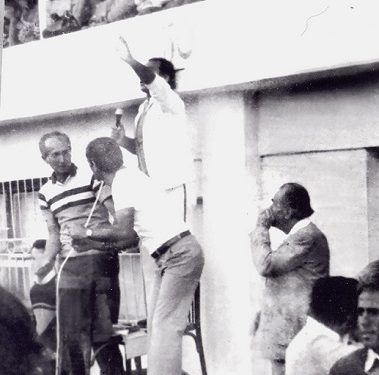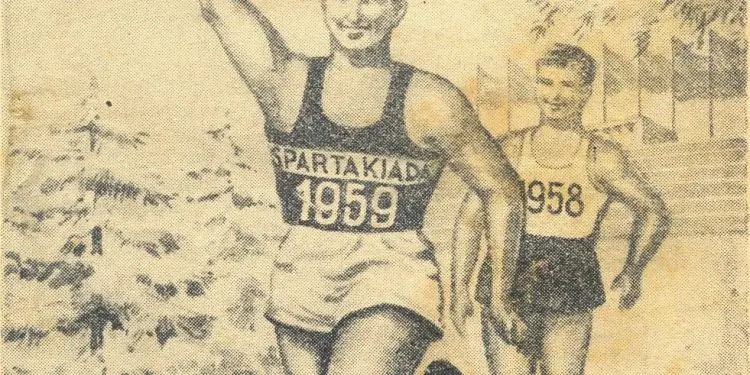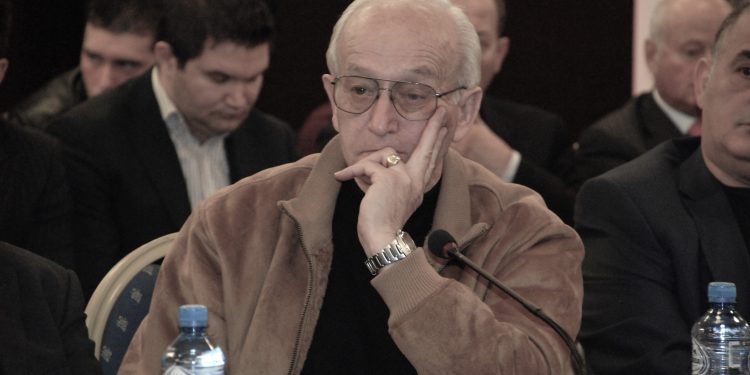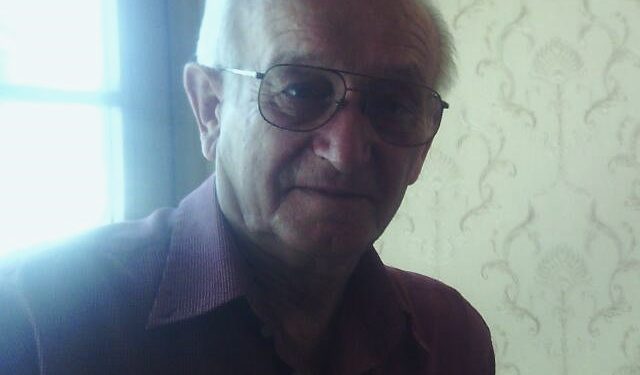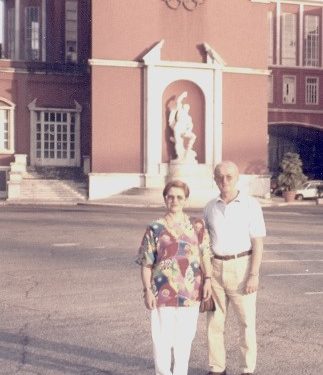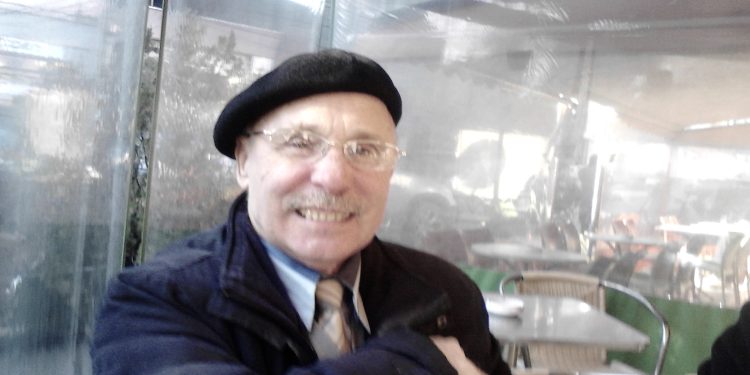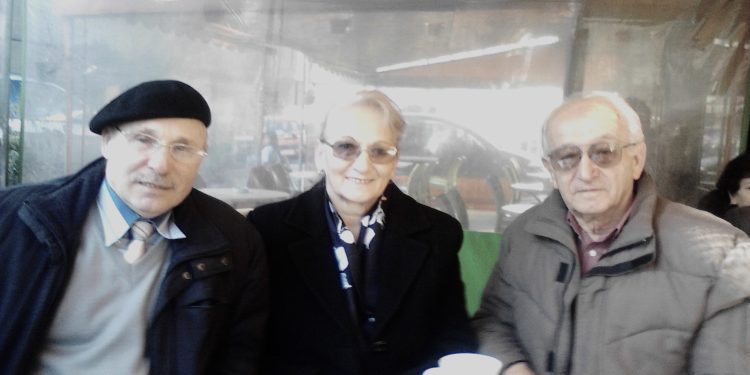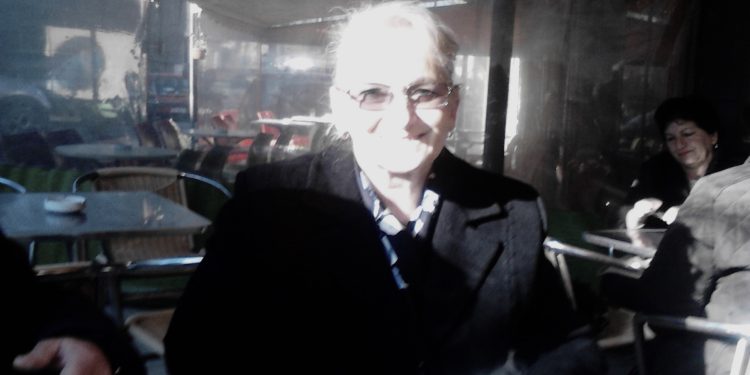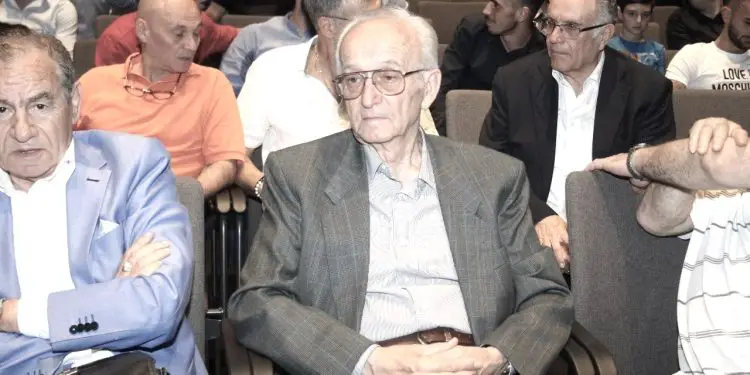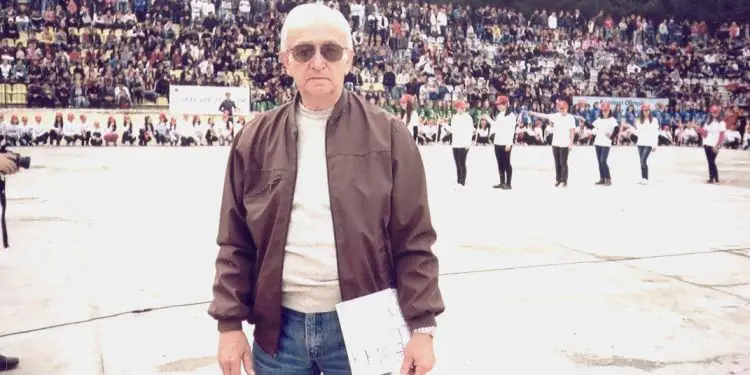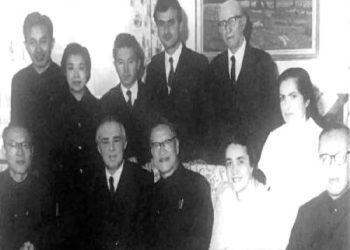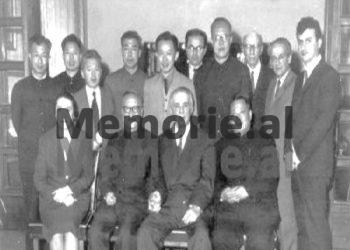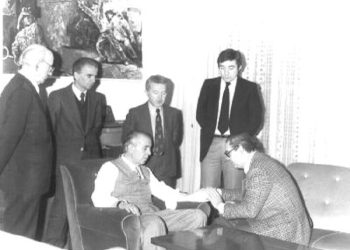From Uvil Zajmi
Memorie.al / The unknown history of the national spartakiades, of those magnificent performances that took place in the National Stadium “Qemal Stafa”, in the capital, under the supervision of the main leader of communist Albania, Enver Hoxha! How were they organized, what was the purpose, what did they demonstrate and where was that model copied from?! “After the return of Enver Hoxha from Moscow, the idea was thrown to develop such giant shows in Albania as well. It was considered the biggest political and sports activity of the country. In the 4th Spartakiad, 300,000 young men and women participated, almost one sixth of the population. The newspaper ‘Zëri i popullit’ did not write my name and in Korça, they removed me from the general rehearsals”, says Petrit Qëndro, who together with the group and his wife, Ana, directed those activities during the years of the dictatorship. The difficulties, the responsibility, the documentation, the rare photos that he still keeps today, etc., Mr. Qendro tells us in this exclusive interview for us.
How did the organization of spartakiades begin in Albania?
There have been several Spartakiads in Albania: student, school, working class, peasant, mining industry workers, young women, cooperative youth, textile workers, pioneers, working and peasant youth, People’s Army, etc. ., etc. Different were the national ones, which took place in total five such. In 1959, the 1st National Spartakiad took place, from October 4-11, 1959 in Tirana, where 10,000 bodybuilders participated. Enver Hoxha was also in the stands. During the spartakiade, 189 records were set and the “17 November” team from Tirana was declared the winner. The 2nd National Spartakiad, which took place on the eve of the 25th anniversary of liberation, was opened on August 24, 1969, at the “Qemal Stafa” National Stadium.
During its development, 98 records were set and the “17 November” team from Tirana was awarded the Spartakiad flag for the second time. And the 3rd National Spartakiad took place in 1974, which was divided into 4 phases. It started on September 16, 1973, and on October 9, 1974, the flag was raised at the “Partizani” Sports Palace, while on October 12, the great opening demonstration of that spartakiade took place at the “Qemal Stafa” Stadium. The main leader of the Party of Labor of Albania, Enver Hoxha, also participated there again. During its development, they set 155 records and the “17 November” team of Tirana, for the third time, was awarded the winner’s trophy.
The 4th National Spartakiad, which took place in the framework of the 35th anniversary of the liberation, took place in 1979 and there were activated about 500 thousand participants from all over the country. There, 173 national records were broken and the “November 17” team from Tirana triumphed again. While in the 5th National Spartakiad of 1984, about 750 thousand people were activated and 155 national records were set there, and again, the capital’s “17 November” team is its winner. For more about the development of these spartakiades, we know the interview with Mr. Petrit Qendro, which we are publishing below in this article.
Professor, first of all, who is Petrit Qëndro and your sports career?
I was born in 1938 in the city of Korça, where I spent my childhood. In the 1950s, I came to Tirana as a student at the “Jordan Misja” Artistic High School, branch of painting, with the teacher the famous sculptor, Master Odhise Paskali. Then, I studied at the Technical College of Physical Culture, in Tirana, and after I was appointed as a teacher, I was a teacher in 18 schools in Tirana and its suburbs. Also, I have been a participant in athletics competitions, in the cycling circles of Albania, a basketball coach and a coach of pole vaulting champions, such as Dh. Deacon, S. Fisheku, and secretary of the Albanian Federation of Athletics and Multi-Sports. Meanwhile, for another 6 years, I was also a physical training instructor for football referees.
Mr. Qendro, how did the idea to organize the spartakiades in Albania come about?
I think that the idea was born during a visit of Enver Hoxha to Moscow, in 1949. Together with Stalin, they had assisted in a mass physical activity held in the stadium. After returning, Enveri gave the idea to organize such demonstrations in Albania as well. As the most distinctive characteristic of Eastern Europe, these types of manifestations found application in the countries of this Block, especially in Albania.
All spartakiades are organized on holidays or anniversaries with national symbols, etc. I had my first contact in 1957. I had just finished the technical school, when Lame Konomi heard about me, and while I was doing my military service at the “Partizani” Sports Club, he called me together with Pal Mirashi, the famous ex-footballer, (at that time a teacher at the “Fan Noli” school), and we were assigned to help the group of the “Partizani” plant and the Shoe Factory, to perform physical training exercises for the working class.
Even in the time of the Bird Kingdom, there were mass demonstrations, right?
They have their origins in the first Albanian school in 1887, when at the end of the school year in its yard, the students, in front of their parents and teaching staff, held a festive ceremony with gymnastic exercises, designed by physical education teachers. However, one of Ahmet Zogu’s sisters also took patronage for sports physical education. In the photos of the time, you can see such performances organized in “Shallvaret”, where the schools are only with girls. There were no slogans, no names, no calls, only movements accompanied by the sounds of music. Even in the “Normal” school in Elbasan or in Vlora, Shkodër, Durrës, Tirana, etc., annual demonstrations were organized at the end of the school year. So a tradition existed.
In June 1946, the first performances known as “gymnastic-sports demonstrations” were seen, which represented the largest physical and cultural demonstration in Albania, up to that time. About 3500 young men and women, demonstrating, from dances, folk games, gymnastics on tools, etc. On June 3, 1949, in the physical culture manifestation of the capital’s schools with about 3,500 students, for the first time three cycles of schools participated, the elementary ones with morning gymnastics exercises, the 7-year-old ones, with an agricultural character, etc. The special one was “Bariu e baresha”, by Luigj Shala, which was appreciated by the press of the time. Accompanied by a musical folklore and choreography, which was considered a qualitative first step.
Do you remember the First Spartakiad?
It was divided into two phases. It started in 1958, with competitions and activities, while in October 1959; the opening ceremony took place on the occasion of the 15th anniversary of the liberation of the homeland. Along with the students and the military, there was also the working class. In front of the stadium, tents were erected where people from the districts stayed and performed exercises. One of the exercises was without uniforms, just torso. To get their color, the athletes sent them to the Durrës beach, where they also prepared. I also remember a ship in midfield, made of cardboard and fabric, by the group of bodybuilders from Durrës.
There were also groups from Shkodra and other cities. Along with the Albanians, there was also an inspector, a Russian woman. I was an observer and for the first time, I saw such clothing. Enver Hoxha was also in the stands. Albanian and Soviet flags were flying. Speeches were given by Manush Muftiu, Vasil Konomi, citizens and former partisans, etc. Students, pupils, workers, bodybuilders, soldiers sent flowers to Enver Hoxha. Likewise the Second Spartakiad: the exercises on a pyramid, executed by the students of lower cycle schools, or the working class, which gave performances with elements from agriculture.
Even popular games, like; kaladibranche, up to 3 floors, or “Locomotive in the tunnel” in the form of a relay, with children, etc. Whereas bodybuilders and soldiers demonstrated order and discipline. Football, basketball, volleyball, boxing, wrestling, etc. matches were held. The event was accompanied by the slogans of the time; “Glory to ALP”, “Glory to Marxism-Leninism”, “Long live ALP”, “Glory to the 15th or 25th anniversary of liberation”, etc.
How did you prepare, what methods did you have?
A Central Commission functioned, part of which were the Minister of Education, the Executive Committee of the district of Tirana, as well as the Technical Commission, with experienced personnel. Putting ideas on paper was the first stage of work. Then the topic of the exercise, the request, the implementation, as well as the initial groups. For this, we also used our imagination, combined of course by the political messages of the time, all on a script that had to be staged. Of course, relying on the knowledge of the environment, the situation, based on individual and group movements. The exercises on the theme of agriculture were carried out with students from the secondary cycle of suburban schools, accompanied by figurative tools, such as baskets, sunflowers, cotton, wheat, etc., with the presence of musical rhythms.
How did it work? Can you tell us any specific details from the spartakiades?
Rehearsals started together with the school season. In the morning in the school yard, in the afternoon the lower cycle ones, in the “Dinamo” stadium, while the secondary ones, in the square in front of the National Stadium, “Qemal Stafa”. Everyone was involved, from those in physical education, but also other teachers. Initially, the program was given, working in groups. Lessons were reduced; everything was focused on the Spartakiad. A week ago, practice started every day in the stadium, where each school had its own sector and each student had his number, his place in the picture and the figures.
Were there party controls before it started?
It was a state commitment, not only of the sports sections. They came from the Central Committee, Party Committee, Executive Committee, and BFSSH, who attended the rehearsals. Especially the general ones, that if there were remarks, they were corrected. Think about the responsibility, the anxiety for teachers, students, school leaders, for us in the work group, anything could happen with such a large number of demonstrators. And the activity continued for more than an hour.
It was said that even the Chinese specialists liked your exercises… How is this story?
It was the end of the school year, at the “20-Vjetori” school, where I was a teacher. A demonstration was held with the sports classes. Along with Mehdi Bushati and Lame Konomi, the chief inspector of sports in the Executive Committee of Tirana, which was responsible for the organization of mass demonstrations, there was also a Chinese specialist. After the demonstration was over, they called me. The Chinese woman, who had liked the activity, said that even though the cycle was low, they should be added to the Spartakiad. He was impressed by an exercise with a net and bands. This was also the moment that I became intensively engaged with the Spartakiads.
Have there been any difficult moments for you, Mr. Stay?
It was an exercise that would be done with the lower cycle of the “Labinoti” school. The Minister of Education, Tefta Cami, was present at the test, which liked it and expressed the opinion that this exercise should be done in high schools as well. We started preparations at the “Sami Frashëri” school. The demonstration of all exercises took place in the “Partizani” Sports Palace. It was much appreciated. Then at the Ministry of Education, an analysis was made, the member of the Political Bureau of the Central Committee of the PPSh and the deputy prime minister of the government, Manush Muftiu, who attended the tests, was also present.
Although the committee applauded there, he started the discussion with my exercise. Since the main figure was a cardboard rifle, he criticized it, saying that; “The homeland cannot be defended with cardboard rifles, even more so by students”! Tefta Cami had the courage to tell him: “Comrade Manush, I have given the order to do it, even with the middle ones”. When we went to rest, someone touched my shoulder, I turned my head, and it was Manush Mufti: “You were sorry, – he told me, – but we can change it, can’t we”? “Of course,” I answered, “we’ll start over.”
“Do you have time?”, he asked me. “Yes”, I told him and asked that M. Lasku help me with the girls, while I had the boys. Avni Mula, who was the composer, to encourage me, hugging me says: “Petrit, we will make it better”.
In the Third Spartakiad, the big change came. Why?
The first two were almost similar. The third started in September 1973, extending to the most remote villages. The second phase, April-May, in areas and sectors, the third June-July, in the district and the fourth phase in Tirana, in October 1974. It was a Spartakiad, where five age groups participated and with five compositions for each group. Even exercises for elementary school children, led by me, at the request of the Chinese specialist. But what made it special was the large frontal background, in the new section just erected at the “Qemal Stafa” Stadium, creating two scenes, two spaces: on the field and in front.
There were 4,000 figurants, for the first time in the history of the manifestations, where they compose figures, slogans with capital letters, perform combined exercises, from students, Skenderbegas, secondary schools, 8-year cycle, etc. Cardboard figures imported from China were used. But, they were of strong colors and, from the sun, created reflexes. Sokol Morina, also from Dekor i Tirana, intervened and changed the colors.
Exciting was the moment when 2,300 students realized for the first time, the opening of the national flag with very large dimensions, directed by the author Edvin Dashi. But also the composition of the high school exercise, boys and girls, authored by Pashobell Resulin, accompanied by Ana Qëndro. The closing was done with the waving of the flag, at the top of a giant pyramid, in the midfield. Everything interlaced with entrances and exits, field cleanings, etc. I was holding the board, where I had the name, the number of the student. The opening and closing ceremonies were important.
In Korça, it is said that you were removed from the rehearsals, what is the motive?
I was a teacher in Baldushk, when Lame Konomi came and told me: “Together with Avni Mula, you will leave for Korça, to prepare a demonstration”. This happened on the eve of the Congress of Professional Unions, where Enver Hoxha would also be present. We had a week, or something more, at our disposal. One day before the general rehearsals with school students, Pirro Lako, the second secretary of the Party Committee of the district of Korça, tells me: “Petrit, you will leave for Tirana”. Got it, biography. I should not have been present at the general rehearsals, as well as on the day of the congress. Avni Mula stayed with the working group, I left.
And the last Spartakiad, the one in 1984…?
From one Spartakiad to another, more experience was gained, starting with the experience gained from the World Olympics. I remember that in the manifestation of 1979, the authors Flora Toto and S. Bejtja presented with the students of the Higher Institute of Physical Culture, “Vojo Kushi”, a very beautiful exercise. Whereas the 1984 Spartakiad was scheduled from October 20-28 and the competitions and matches took place at the “Qemal Stafa” Stadium, the “Partizani” Sports Palace, the sports palaces in Shkodër, “Punêtori” in Durrës, the training grounds of Tirana, etc. While the chess meetings, in the Great Palace of Culture in Tirana.
Many elements were needed, especially the colored uniforms, how were they found?
There were difficulties, but a state was standing. The uniforms were ordered from the “Stalin” Textile Factory in Tirana and the Korça Knitting Factory. It was important to use the colors of the clothing, harmonized with those of the environment, the lighting, the size of the surface, the decor, such as the frontal and side ones.
How was its publicity? Even the magazine “Nuova Albania” reached fame!
From the newspaper “Popular Sport”, to “Zëri i popultil”, “Bashkimi”, etc., their front pages echoed the Spartakiad. Especially when Enver Hoxha was also at the opening. From 1974 onwards, it was also Albanian Radio-Television. Even rhymes, songs, poems, have been created by well-known authors, such as “Trupkalitur e saženzjarrte”, “Strength and courage forever” or “Laughing heart and take a step”, etc., etc. The documentaries featured parts from the opening ceremony, competitions, etc. In the same way, magazines, even those in foreign languages, were propagandized with writings and slogans such as: “Manifestation of the revolutionary youth”. “We work, learn, live and behave like revolutionaries”. “The demonstration was a clear expression of the revolutionary drive, strength, health and aesthetics of our youth”, etc., these were the messages.
How important was a medal in the Spartakiad?
Being declared the winner of the Spartakiad was a great event for the Sports Clubs, the individual and for all sports, both individual and team. Gold, silver and bronze medals were awarded to the winners. When the final stage took place, all other activities were suspended, as the competitions, the Spartakiad matches, were included in the annual sports calendar. There were no financial rewards, only decorations, with: “Naim Frashari” of the 1st, 2nd, 2nd, or sports classes; “Master of Sports” or Merited Master of Sports”.
What do you remember from those spartakiades?
There are three football matches. In 1969, “November 17” – “Dinamo” 2-2, after which they had equal points and goal difference. Penalties are called. Ali Mema scores 5, compared to “Dinamo’s” 3. In 1974, in football again, the gold medal would be determined by penalties, “Dinamo” – “Vllaznia”, 1-1 after 120 minutes of play and “Dinamo” wins 5-3. And in 1979, in the final football match “Dinamo” – “November 17”, 1-0, Ilir Përnaska’s goal.
I remember a women’s basketball game, “November 17” – “Skënderbeu”, 103-57 and Bukuroshe Shtiza, scoring 32 points. Agim Fagu’s “Partizanin”, which had no rivals, as well as Vangjel Koja’s “Dinamon”. Then the athletes Marjeta Pronjari, Pavlina Evro, Marinda Preka, Rifat Deliu, Fatmir Bajraktari, Ajet Toska, Elisabeta Karabolli, Diana Mata, Klodeta Gjini, Mihalin, Kalleshi, Asim Belinova, Zino, Rama, etc., etc., forgive me for not i can name them all.
In addition to the spartakiades, military parades were also held for July 10, or November 28-29, and those of the working class for May 1…?!
They were the most important and took place on the great “Dëshmorët e Kombit” Boulevard. Preparations by the group started a month before, with concrete plans that were sent to the schools. The demonstration in front of the tribune, where the leadership, Enver Hoxha, etc., was important. But the demonstration on the occasion of the 40th anniversary of the People’s Army was the most successful I have done. It took place on July 9, 1983, at the “Qemal Stafa” Stadium, with a background that read “1943-1983 People’s Army”.
Initially, it was thought to be held at the “Emver Hoxha” United Officers’ School, but when Enver Hoxha finds out, he calls the Minister of Defense, Prokop Murra, to whom he says: “What is this party for, for the officers’ families?! The army is not theirs, but the people’s. It should be done at ‘Qemal Stafa'”, he orders firmly. Enver Hoxha himself was present. We only had 20 days.
We have heard that in order to get your and your wife’s name published in the newspaper “Zëri i popullit”, the work went all the way to Enver Hoxha! How is the truth of this, can you tell us?
After the demonstration, there was great enthusiasm in the stadium. Enver was on the podium, when a journalist from “Voice of the People” is said to have asked him: “Comrade Enver, what should we do with this Qendron, let’s publish his name in “Voice of the People”, because his wife Ana did not appears with the last name Këndro, but with hers, Martinian?” “Who told you,” he answered, “not to name him?” The journalist himself told me this, but I can’t say exactly how much truth there is here.
What was the working group that you speak with a lot of admiration and appreciation?
We were some friends, acquaintances, physical education teachers. M. Lasku, Anna and I, spouses Eli and Sokol Morina, E. Dashi, soldier Tafil Hamzai, P. Resuli, all dedicated. We discussed, ideated, designed and we were the ones who approved them and took over the organization. (Also, I had the unsparing help and support of my wife, Ana, my colleague, co-worker, the closest person in my family, work and life, whose absence I feel very much even today). Not forgetting the work group, extraordinary! But there are also some important figures, with a great contribution to these manifestations, that I want to remember, such as Agim Zajmi, Luigj Shala, S. Shuteriqi, Xenofon Dilo, Zef Hila, D. Lisi, E. Bushati, V. Naqi, Lame Konomi, Flora Toto, S. Bejtja, etc.
Professor Petriti, you have an outstanding documentation. How have you preserved and how do you judge those activities today?
I archived them after each manifestation, as you can see. They still hold up well. I worked in blocks, I recorded up to 8,000 registered names. I knew exactly the student’s first and last name, the square he had. How do I judge those activities today? It is true that sport is not politics, but the Spartakiads had their value! Memorie.al




